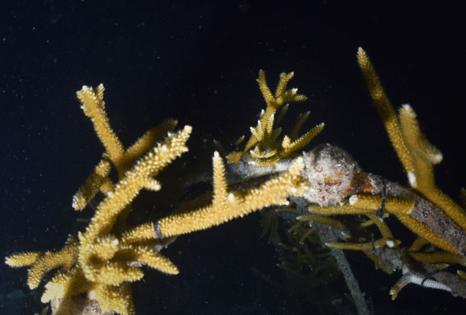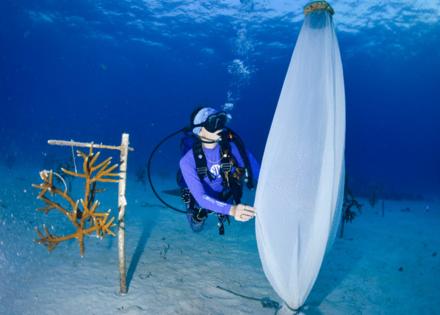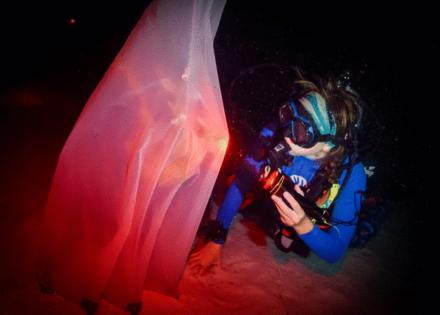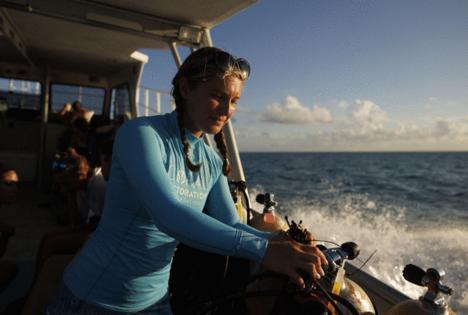It's hot on Florida reefs and not just the water. Rare coral sex a hopeful sign
Published in Science & Technology News
Beneath a cloak of darkness, illuminated only by glow sticks and red-filtered flashlights, researchers waited underwater off Key Largo hoping to witness one of the rarest events of sex in the sea.
It’s a delicate spectacle called the coral spawn — a once-a-year phenomenon when Florida’s reef-building coral colonies simultaneously release tiny bundles of eggs and sperm. They float to the surface in a scene that can look like a shaken snow globe.
The spawn, which typically takes place over a few days and lasts less than 20 minutes, is triggered by subtle environmental cues — moon phase, tides and water temperatures — that healthy reefs once responded to in consistent synchronization. But in recent years, climate change has disrupted the reproductive rhythm.
A mass bleaching in 2023 fueled by record coastal water temperatures devastated Florida’s reefs, leading to what Coral Restoration Foundation scientists call an “asynchronous stress spawn” where corals released undeveloped eggs and sperm too soon — as if in a last-ditch effort to reproduce before dying. But that happened so early that breeding was largely a bust.
So this spawn was absolutely crucial for the future of Florida’s coral reefs and for researchers working to revive them. The mix of hope and uncertainty was emotional for Roxane Boonstra, an education coordinator with the Coral Restoration Foundation, who teared up before jumping in the water one night this week.
“The bleaching was hard on the coral, like they had a fever,” she said. “The degree of warming was not normal, and for them to come back and spawn would be so amazing.“
To their relief, the corals delivered. It was the first successful spawn for staghorn coral growing in the Coral Restoration Foundation’s nursery since the 2023 mass bleaching.
Spawning is a big benchmark for the health for any coral colony, but especially for nurseries the foundation and other restoration programs see as key to rebuilding more resilient reefs, said Alex Neufeld, the science program manager at Coral Restoration Foundation.
“Corals, like with any other species of animal, they’re not going to put energy and resources into reproduction if they’re not healthy,” Neufeld said. “If we see viable eggs, then it means that all of the other basic life needs of the coral must be being met. It means our colonies are healthy and that we’re doing something right.”
Still, there are still signs that Caribbean seas could cook again this year before summer ends, unless passing storms like Tropical Storm Erin help cool them off.
Coral reproduction is a bit of long shot to begin with. In the wild, coral eggs and sperm are released into the water and left to find each other in the drift of current. But with high risks of eggs and sperm drifting apart or being eaten, coupled with ocean warming and pollution, very few survive and turn into larvae, and even fewer settle at the bottom of the ocean and grow into corals.
“They’re just at the mercy of the waves in the water,” said Neufeld.
And because bleaching and other problems have decimated many reefs, neighboring corals are farther apart, making it harder for them to get together at the surface, Neufeld said. Think of it like swiping on Hinge and everyone being too far away to be worth the drive to meet up.
So scientists hope to step in to assist, carefully collecting and managing the spawning process to improve the odds.
Racing against the clock
At dusk, a few hours before the coral were expected to spawn, the team descended into the nursery they call "spawning alley.” The nursery consists of coral fragments that dangle from hangman structures that the Coral Restoration Foundation put 30 feet under the surface.
The second descent was just after 10:00 p.m. At night, everything looks different underwater. Bloodworms dart in front of flashlights and green bioluminescence appears with motion in the total darkness.
The researchers look closely at the coral for something called “setting”, which is a sign that the spawning is about to start. To the untrained eye, it’s hard to see. Scientists describe it as a pimple that looks ready to pop.
Once the eggs and sperm sacs — known as gametes — are released, researchers have just 35 to 45 minutes to retrieve the tiny bundles in a test tube before they start breaking apart into sperm and egg. It’s important to get the gametes to the lab before they start separating to fertilize on their own, Boonstra said, so researcher can cross genetic variants, a process designed to improve resilience to rising sea temperatures.
The gametes, roughly the size of Dippin’ Dots, are collected in tube delivered to the vessel operated by the Chicago-based Shedd Aquarium.
On the boat, the Shedd scientists make a coral cocktail combining equal amounts of different generic variations of coral into one tank. It’s gently mixed and separated into different containers.
“We have to keep it really even, to give everybody a chance. We’re really just trying to increase our chance of settlers that will be able to actually contribute to this new genetic diversity, which builds more resilience,” said Shayle Matsuda, an ecologist on Shedd’s boat.
The divers went to collect gametes each night this week. On Monday, there were small amounts of spawning, and on Tuesday, when the Herald joined, there was a little more. Wednesday night was a much bigger event, and thousands of gametes were collected, Matsuda said. They’re expecting Thursday night to be even better.
“They’re looking good,” Matsuda said.
Cutting-edge experiments
The scientists are also running different experiments on the boat using these larvae to try to bolster heat tolerance.
Some of the gametes were given to SEZARC, a group of zoos, aquariums and conservation centers focusing on solutions for reproductive challenges, to be frozen to use later at a later time, and others were put through heat stress tests.
Kevin Wong, an assistant scientist in the Cnidarian Immunity lab at the University of Miami, is using stem cells from the heat-tolerant corals they identify to try to infuse adult corals with more heat-tolerant DNA.
“It’s kind of a similar concept to stem cell transplants, like those bone marrow transplants for humans between humans, to help remedy cancer,” Wong said.
But unlike humans, corals don’t tolerate being stuck with needles. Instead, Wong said they created small chambers where coral fragments soak in new cells for about eight hours — long enough to absorb the treatment but not long enough to where they die from limited water flow.
Hope for the future
Neufeld said Coral Restoration Foundation had a “very successful night” on Wednesday. Researchers were able to collect gametes from 14 of the 29 staghorn genotypes from the Coral Restoration Foundation. They also collected samples across much of the reef tract from off Biscayne Bay south to the Dry Tortugas.
They weren’t the only nursery that had a good night. About 200 yards north, Reef Renewal USA, another coral nonprofit, also had a large spawn in Key Largo, including from another rare species called elkhorn coral. Staghorn and elkhorn are both important because they are fast-growing corals that produce large branches, and they once dominated reefs off South Florida, said Ken Nedimyer, Reef Renewal’s technical director.
“Every one of our structures and genotypes spawned last night,” said Ken Nedimyer. “Can we do it at scale? And can we breed enough heat resistance into it to last through the century? I don’t know, but you don’t know until you try.”
What researchers can’t control are global climate changes. While the spawn was promising, this week also saw underwater temperatures on many of those same reefs rise to dangerous levels. So dangerous, in fact, that federal coral reef monitors gave the official “stand down” order to coral replanting groups earlier this week.
The National Oceanic and Atmospheric Administration warned coral nursery groups that water temperatures had risen to 30.5 degrees Celsius, the threshold for coral bleaching. The Keys were elevated to an alert level 1 for bleaching on Monday — the second-highest level of the warning chart. At that temperature, baby coral fragments in the wild might not survive.
The only group allowed to go on with its replanting was a team of researchers placing new fragments explicitly designed to weather extreme marine heat.
But some relief may be on the horizon. Tropical Storm Erin is expected to pass north of the Caribbean over the weekend as a large, powerful hurricane. The outer waves and winds of the storm will likely cool off the overheated reefs, giving the corals a bit of a reprieve before temperatures pick back up again.
Matsuda, the Shedd scientist, said experiments like these give hope of a solution that’s not only building resilience on the reef but creating a scalable solution. It requires a lot of time and resources to apply treatments to individual adults, he said, but with reproduction, they’re working with hundreds of thousands of larvae at once.
“If we can find something that helps those larvae survive, it could have a much larger impact downstream,” Matsuda said.
_____
(Alex Harris contributed to this report.)
_____
Ashley Miznazi is a climate change reporter for the Miami Herald funded by the Lynn and Louis Wolfson II Family Foundation and MSC Cruises in partnership with Journalism Funding Partners.
_____
©2025 Miami Herald. Visit miamiherald.com. Distributed by Tribune Content Agency, LLC.
















Comments